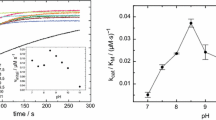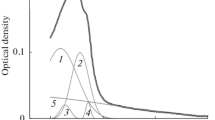Abstract
Pulse nanosecond fluorescence anisotropy decay has been used to study the mobility of tryptophan residues within fungal lipase fromHumicola lanuginosa. The decay of emission anisotropy of protein in native, inhibited and mutated form has been investigated in buffered water and 50% v/v glycerol solutions. The rotational motions of the lipase were analyzed in terms of two different kinetic models. It was found that the fluorescence emission anisotropy decay can best be desribed with two rotational correlation times: 0.63 and 5.45 ns in water and 0.98 and 10.70 ns and in 50% v/v glycerol solution. Using the same experimental conditions the decay of inhibited and mutatedH. lanuginosa lipase showed a similar biexponential character. These results are interpreted in terms of local or segmental motion arising from a mass of about 1083 daltons which corresponds to the ‘lid’-helix fragment of the enzyme.
Similar content being viewed by others
Author information
Authors and Affiliations
Rights and permissions
About this article
Cite this article
Stobiecka, A., Wysocki, S. The decay of the fluorescence anisotropy of tryptophan residues in fungal lipase fromHumicola lanuginosa . J Radioanal Nucl Chem 232, 43–50 (1998). https://doi.org/10.1007/BF02383710
Received:
Issue Date:
DOI: https://doi.org/10.1007/BF02383710




